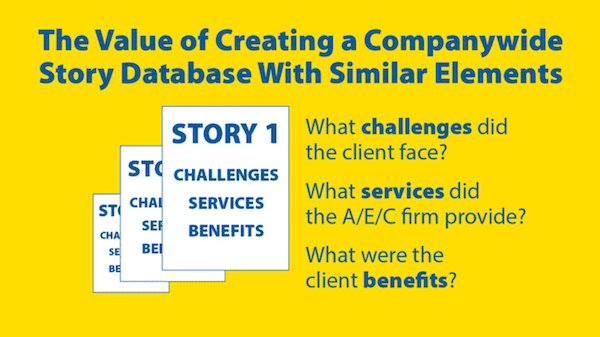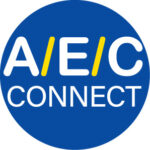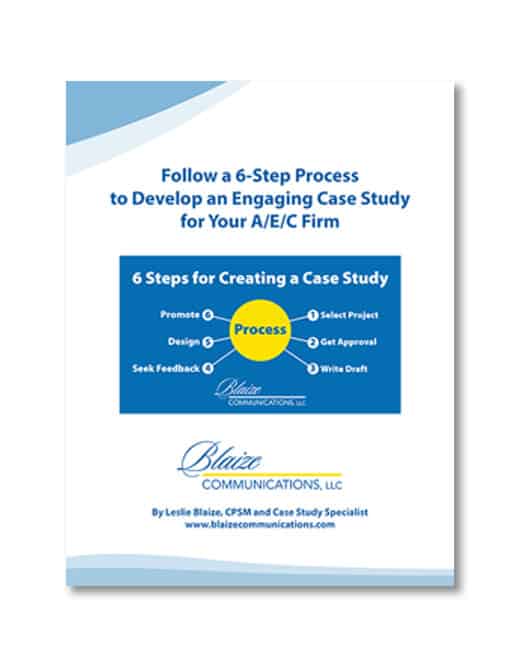After successfully completing a major Architecture/Engineering/Construction (A/E/C) project, management may share the details with great pride both internally and externally. Teams receive client praise, and end users benefit.
But what happens one year later? Three years later? Five years later?
Firm personnel and clients go elsewhere. Critical elements of the story may be forgotten. That oversight could be a big mistake if a company is submitting a proposal on a similar project with related challenges. Repeating that client success story could be a game changer.
Archiving project stories helps firms retain organizational knowledge and avoid this scenario. Dean Hyers, co-founder of SagePresence, St. Paul, Minnesota, recommends developing a structured storytelling method to consistently archive strategic stories.
He worked with a construction firm to document stories based on the client’s initial situation, the help provided, and the resulting positive outcome. For each key project, key employees identify these elements:
- Who is the main character with a problem?
- What challenges did they face?
- What did we do?
- Where did it take them?
“The point of the story is that these people were suffering, the firm solved their challenges, and now the client is thriving,” he says.
Professionals can be encouraged to add before and after metrics, cost and time savings, and innovative solutions to make the stories more compelling.
When a project manager or marketer wants to prove how the firm solved a problem facing a potential client, that individual can check out the storytelling database. There may be a good story that fits with another client’s challenges. It can demonstrate how the A/E/C firm successfully solved the problem.
The project pulled from the storytelling database may have been delivered in a different office. However, it’s still proof that the company knows how to address specific challenges.
Use Stories in Client Interviews
Hyers relates the story of a construction firm that was selected to build a science laboratory for a school. It was supposed to be completed at the start of the school year. The firm realized that the schedule must be adjusted to accomplish this goal.
Changes included:
- Getting permits six months earlier
- Compressing the design schedule
- Breaking ground sooner
If the company needs to prove it can handle an aggressive schedule, this project story is readily available.
Hyers reports that the construction firm used this schedule story in a client presentation. The judging panel also learned that the company had selected a project team with a proven background in meeting tight construction schedules.
Because of the story database, everyone in the firm has access to the story as opposed to only personnel involved with the project.
A consistent story format ensures “a continuity of communication with everyone using the same tool,” Hyers explains. “You get a culture of people who think of story the same way, which helps create a more consistent brand experience.”
A growing story database can help preserve a company’s problem-solving legacy.
Bring Stories Into Question and Answer Sessions
Hyers works with teams to use stories in the Q&A portion of client interviews. For example, an interview team could ask an A/E/C team how they would maintain a building. Some firms may recommend the use of straightforward technology.
Hyers’s client had a more robust answer. The presentation team noted that facility managers have a challenging role. They often need to hire student labor without technology degrees. That’s why the firm recommends the selection of easy-to-use equipment. Their answer demonstrated more knowledge about the situation.
Stories Shape an A/E/C Firm’s Brand
Another challenge firms face is living their brand. The C-suite, marketers, and business development staff may agree on a brand. Messaging and colors are consistent throughout the collateral, website, and social media, but are employees living the brand? And if so, are critical stories preserved?
Hyers shares the story of an engineering company that places a high priority on the client’s experience working with them. “The engineering company focuses on people first and solving problems second,” he says.
Through stories, that firm can translate its brand into a value proposition showing their differences. Structured storytelling encourages consistent communication throughout an organization to help create a uniform brand experience.
When considering the project story, management can encourage employees to reflect on how the team lived the company’s brand to deliver a positive outcome.
Reuse Stories
Companies can turn to their story database when preparing related proposals. But it also could be a source of inspiration for marketing outreach.
Companies can earmark project stories for industry awards, potential blog posts, or client-focused case studies. If approved, client quotes can be pulled out for testimonials. A firm also could tell the story through a video post.
In addition, story details can add emotion to project summaries for websites.
The stories will clearly articulate challenges faced by the client, services provided, and successful outcomes.
Focus on Helping Others
Professionals in the A/E/C industry often don’t like talking about themselves. In this story structure, the employees talk about how they helped the main character in their story — the client.
We’re at our best when we’re not about us,” Hyers emphasizes. “In the stories, the employees are talking about moving the main character to a better place.”
Want to Know More?
For a free consultation, contact me or email blaizecommunications@gmail.com. I can write your case study, provide coaching, or give advice on getting started. I’m also available to speak and present on how to develop a case study with a little help from AI.
Subscribe to A/E/C Connect LinkedIn Newsletter if you’re interested in learning more.



